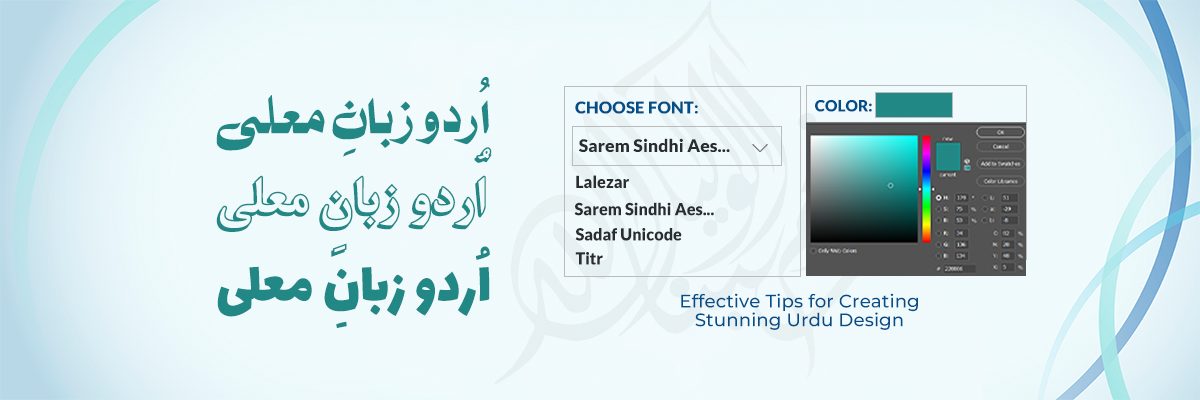Creating the visually appealing Urdu designs is an art. It involves the creativity and the understanding for creating the masterpieces that strikes well to the eye of viewer. Urdu is a beautiful language. It is known for its graceful and flowing script. But yes, we know that designing in Urdu is little tricky and has its own challenges. The reason behind it is its own rules, direction, and scripts.
Brands also use Urdu to connect with the local audience and many people also prefer to see designs in their own language. In this article, we are going to guide you through the five best practices for creating eye-catching Urdu designs that are both visually appealing and meaningful. By following these tips, you will be able to create designs that not only look beautiful but also reflects your message clearly.
Are you searching for the best resources to enhance your design projects with beautiful Urdu fonts? Here are the 10 best websites for free and premium Urdu fonts.
5 Essential Tips for Designing Striking Urdu Visuals
Learn more about the five important tips to help you create beautiful and eye-catching Urdu designs. These tips will guide you in using colors, fonts, and cultural elements effectively to make your visuals stand out and communicate your message clearly. Here the tips are listed below.
Choosing the Right Font
Choosing the right font is one of the most important steps in creating eye-catching Urdu designs. The font you select will influencer how your design is perceived, especially in terms of readability, aesthetics, and appeal. As we know that the Urdu is the script-based language, so it should complement the message and mood of the design. Nastaleeq is the most popular and widely used font for Urdu. It is highly recommended for designs and creates a classic and graceful feel. Jameel Noori Nastaleeq or Alvi Nastaleeq are also the modern versions of classical scripts. In addition to style, readability also matters. If the font is too small or too decorative, the message can get lost.
Organize Your Design for Easy Reading
Maintaining the sequence or visual hierarchy is very important in any design, especially when you are working with the Urdu calligraphy fonts. It means that arranging text and design elements in such a way that guides viewers’ attention naturally from the most important parts to the lesser important one. A well-organized design makes it easier for the audience to understand the message quickly and clearly. If the text is too cramped, it will be difficult to read. Color is another powerful tool in maintaining visual hierarchy. Proper spacing between text, images, and other elements helps to keep your design clear and organized.
Use Colors Wisely
Colors in Urdu designs are not just decorative, but they also convey emotions and messages. Like for example, in Islamic or the traditional contexts, colors like green or gold are mostly used for their spiritual association. For the corporate or modern designs, you can explore a wide range of colors, but they must complement the Urdu script.
Utilize the Cultural Elements in Your Urdu Designs
Utilizing cultural elements into your Urdu designs is a key to making them more meaningful and appealing to the audience. Urdu is deeply rooted in the culture of South Asia. When you include cultural elements into your designs it creates a strong connection with your audience. The reason is that they can relate to the symbols, patterns, and the themes that represents their heritage. Calligraphy can be used as a cultural element as it can give your designs a timeless and elegant look. From the traditional patterns to symbols related to culture, using these elements can make your designs not only eye-catching but also meaningful.
Optimize for Digital and Print
The use of Urdu is increasing in digital spaces. It means that your designs must work on screens as well as on prints. This requires careful attention to file types, resolution, and the font rendering. Nastaleeq fonts might not render properly on all devices, so you should ensure compatibility with different platforms.
Font Suggestions to Elevate Your Urdu Artworks
Here are some of the suggested fonts you can use in your Urdu designs. You can access them through the links give next to them and can visit our website urdufonts.com for more such fonts and better experiences related to Urdu typography.
| Sr. | Font Name | Developer |
| 1. | Lalezar | Borhna Izadpana |
| 2. | Titr | Kostas Bartsokas |
| 3. | Arif | Axis SoftMedia Pvt. Ltd |
| 4. | Sadaf Unicode | Axis Softmedia Pvt. Ltd. |
| 5. | 2 Narenj | Mrtsoft |
| 6. | XB Kayhan Sayeh | Behnam |
| 7. | Adwa Assalaf | Heidelberger Druckmaschinen AG |
| 8. | Adobe Naskh | Muhammad Zuhair Ruhani Bazi and Robert Slimbach |
| 9. | Sarem Sindh Online School | Sanaullah Mangnejo Sarem |
| 10. | Zarreen | MacFarsi |
Bottom Line
Creating eye-catching Urdu designs involves creativity and attention to detail. By following these five practices, you can create designs that are not only visually appealing but also meaningful and effective in conveying your message. Remember that good design is all about balance and clarity. Whether you are working on posters, flyers, or social media graphics, keeping these tips in mind will help you make a strong impact and attract the attention of your audience. With practice and creativity, you can master the art of designing eye-catching Urdu visuals.



